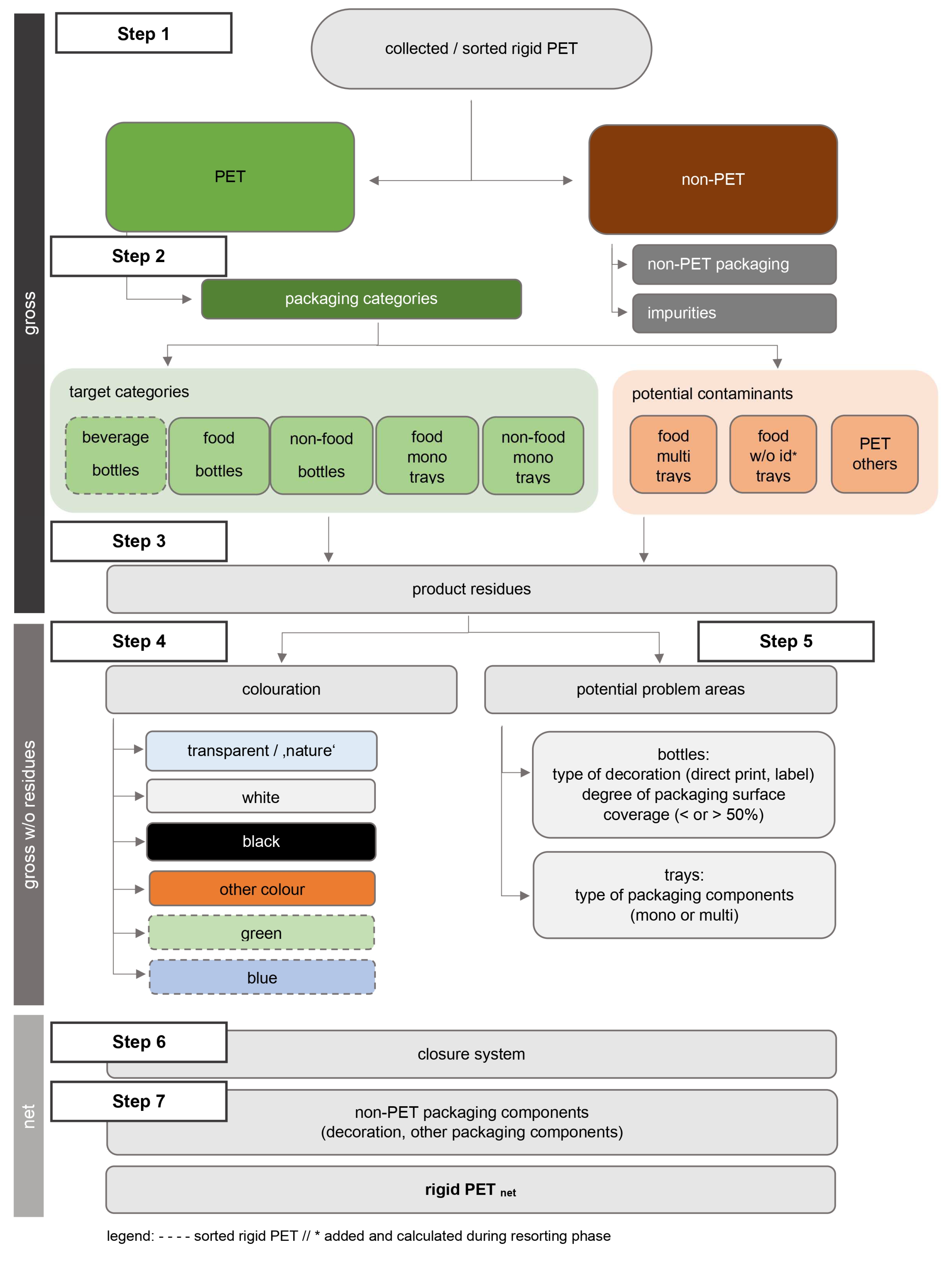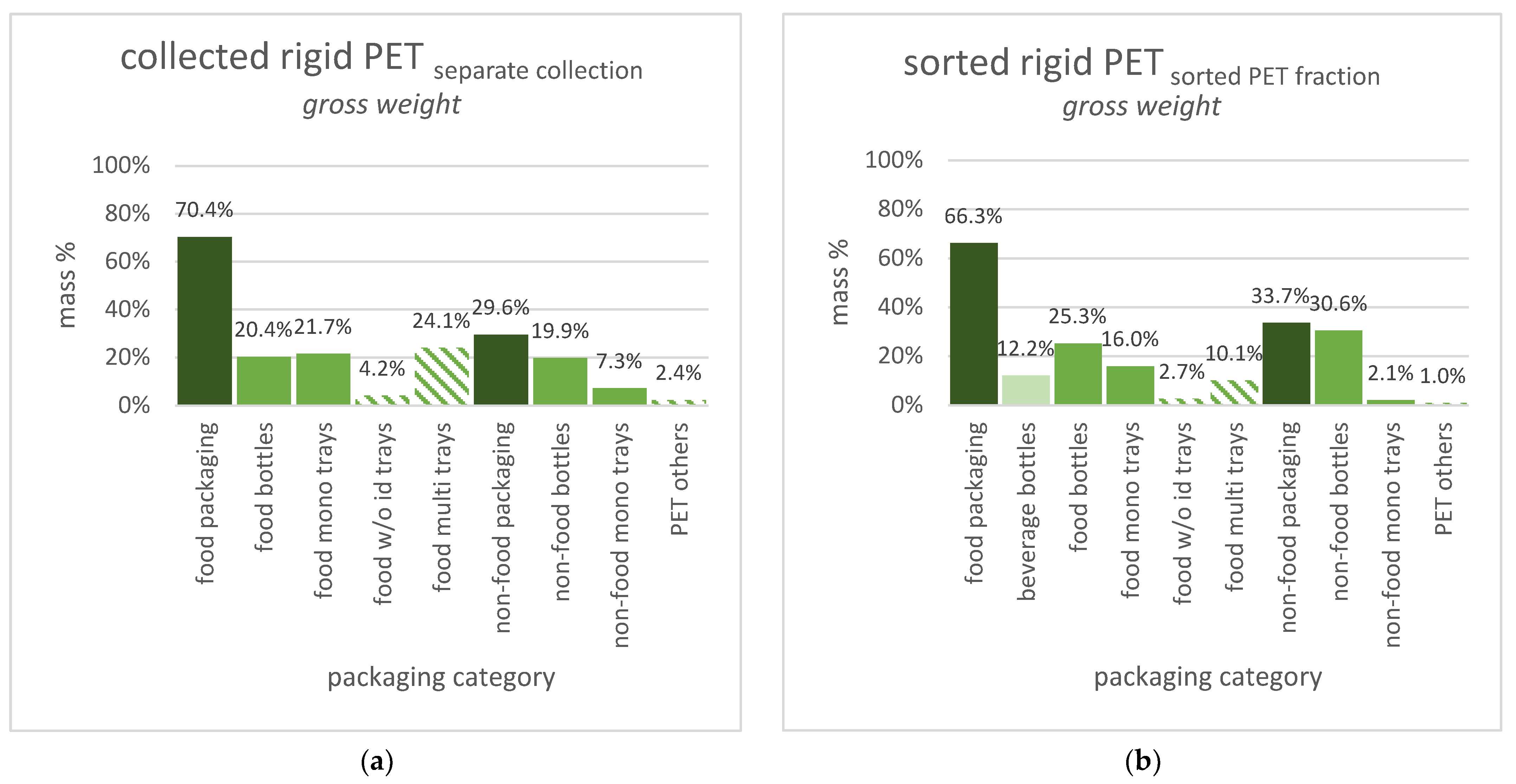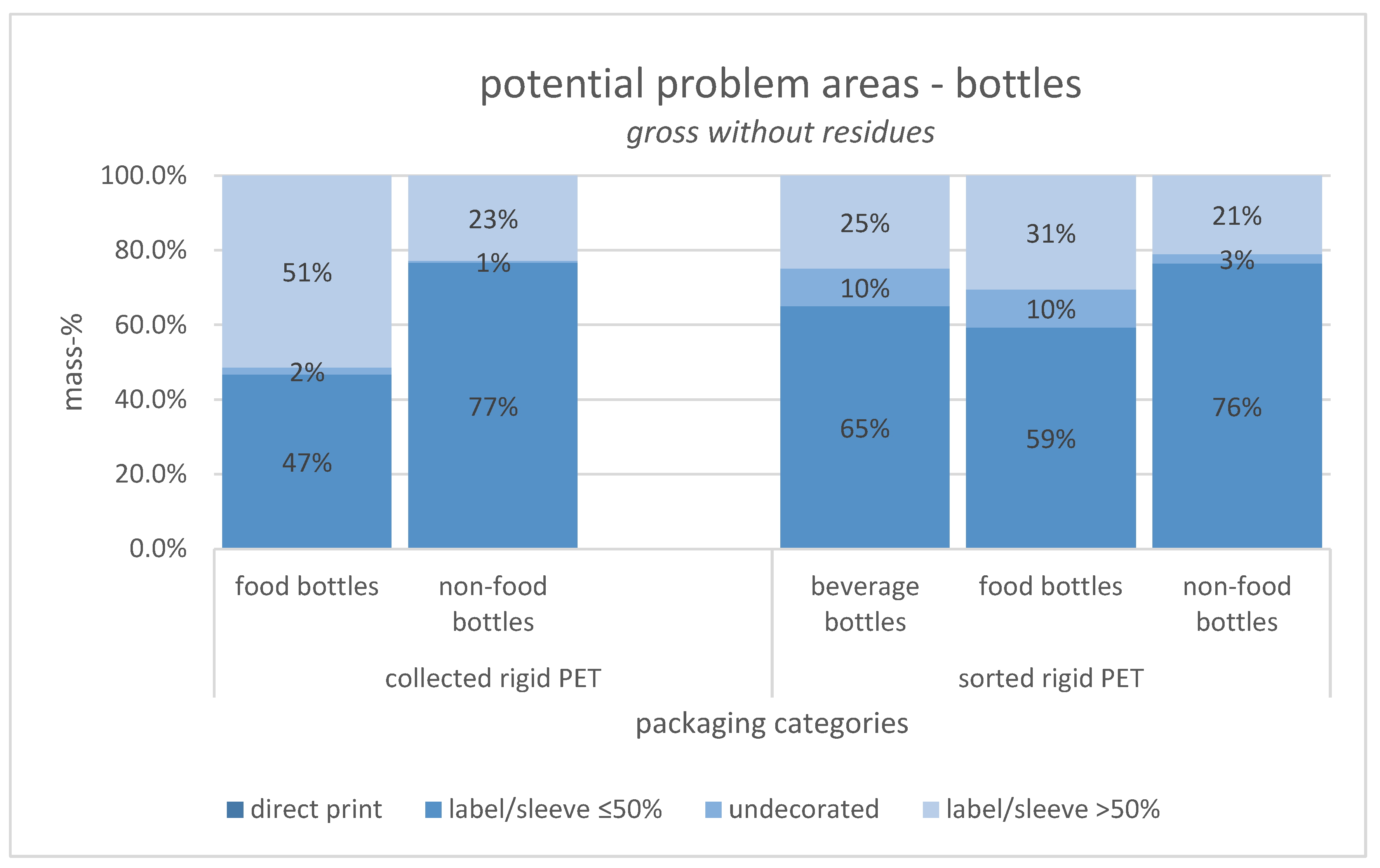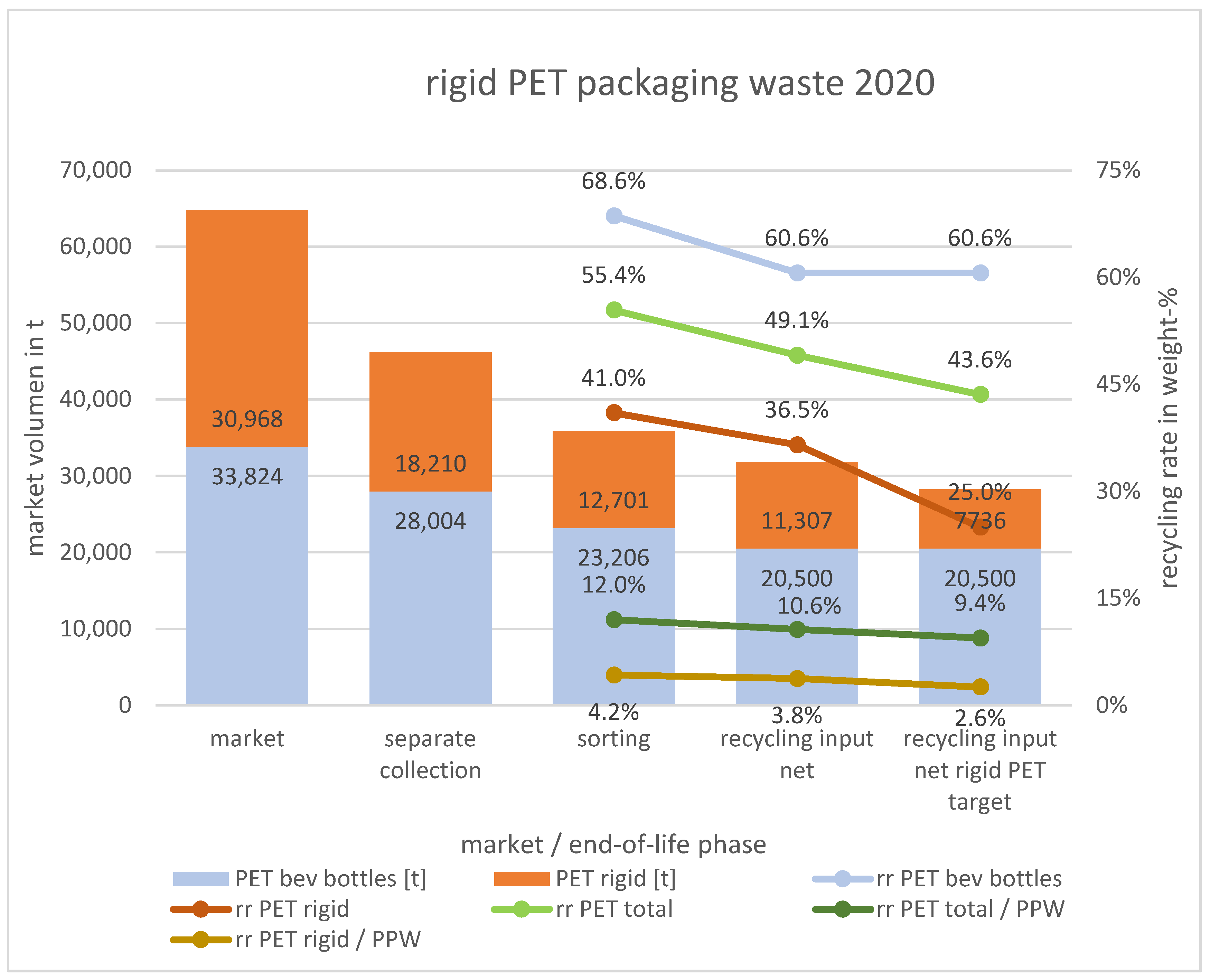Rigid Polyethylene Terephthalate Packaging Waste: An Investigation of Waste Composition and Its Recycling Potential in Austria
Abstract
:1. Introduction
1.1. Market Figures
1.2. Waste Management
1.3. Recycling Rate Methodology
1.4. Aim of This Study
- (1)
- Identification of the qualitative and quantitative composition of rigid PET packaging waste contained in the separate waste collection (collected rigid PET) as well as in the remaining PET sorting stream after beverage bottles are sorted out (sorted rigid PET)
- (2)
- Extrapolation of the total amount and recycling potential of rigid PET packaging waste for the year 2020 in Austria.
2. Materials and Methods
2.1. Overview of the Applied Methodology
2.2. Manual Sorting Analysis
2.2.1. Sampling
2.2.2. Minimum Sample Size
2.2.3. Manual Sorting Procedure and Data Collection
2.3. Extrapolation of Waste and Recycling Potential
3. Results
3.1. Results from the Manual Sorting Analysis
3.2. Extrapolation of the Waste Amount and Recycling Potential
4. Discussion
4.1. Results from the Manual Sorting Analysis
4.2. Extrapolation of the Waste Amount and Recycling Potential
4.3. Limitations
5. Conclusions
- Representative results for a total year might be seasonally variable limited due to short period of sampling.
- Insights into the sorting efficiency are limited due to the absence of sorting trials.
- Rigid PET accounts for 11 mass % contained in the separate collection.
- Extrapolated waste amount for rigid PET is estimated at between 26.3 and 35.6 kt for 2020.
- More than two-thirds account for food packaging and the majority is transparently colored.
- Packaging containing residues with more than 1% of total packaging weight as well as adherent non-PET components might negatively affect the sortability.
- The quantitative contamination potential of the sorting output (sorted rigid PET exclusive beverage bottles) from foreign materials amounts to 11.2 mass % of the total packaging weight, which comprises residues: 0.7%, closures: 8.5%, and non-PET packaging components: 2.0%. This results in an applicable net quantity indicator of 0.888.
- The recycling rate for rigid PET is projected to be 37%, and for the respective target categories to be 25%.
Supplementary Materials
Author Contributions
Funding
Data Availability Statement
Acknowledgments
Conflicts of Interest
References
- Plastics Europe. The Circular Economy for Plastics: A European Overview. 2022. Available online: https://plasticseurope.org/knowledge-hub/the-circular-economy-for-plastics-a-european-overview-2/ (accessed on 12 October 2022).
- European Parliament. European Parliament and Council Directive 94/62/EC of 20 December 1994 on packaging and packaging waste: OJ L 365. 2018. Available online: https://eur-lex.europa.eu/legal-content/EN/TXT/HTML/?uri=CELEX:01994L0062-20180704&qid=1678852881190&from=de (accessed on 15 March 2023).
- BMLFUW. Verordnung des Bundesministers für Land- und Forstwirtschaft, Umwelt und Wasserwirtschaft über die Vermeidung und Verwertung von Verpackungsabfällen und bestimmten Warenresten (Verpackungsverordnung 2014). 2014. BGBl. II Nr. 184/2014. Available online: https://www.ris.bka.gv.at/GeltendeFassung.wxe?Abfrage=Bundesnormen&Gesetzesnummer=20008902 (accessed on 22 August 2023).
- BMK. Bundes-Abfallwirtschaftsplan (BAWP) 2023: Teil 1, Wien. 2023. Available online: https://www.bmk.gv.at/themen/klima_umwelt/abfall/aws/bundes_awp/bawp2023.html (accessed on 7 March 2023).
- European Commission. Commission Implementing Decision (EU) 2019/665 of 17 April 2019 amending Decision 2005/270/EC establishing the formats relating to the database system pursuant to European Parliament and Council Directive 94/62/EC on packaging and packaging waste (notified under document C(2019) 2805) (Text with EEA relevance). 2019. Available online: https://eur-lex.europa.eu/legal-content/EN/TXT/HTML/?uri=CELEX:32019D0665&from=EN (accessed on 7 March 2023).
- European Commission. Proposal for a Regulation on Packaging and Packaging Waste, Amending Regulation (EU) 2019/1020 and Directive (EU) 2019/904, and Repealing Directive 94/62/EC: COM(2022) 677 Final. 2022. Available online: https://environment.ec.europa.eu/publications/proposal-packaging-and-packaging-waste_en (accessed on 10 March 2023).
- Van Eygen, E.; Laner, D.; Fellner, J. Circular economy of plastic packaging: Current practice and perspectives in Austria. Waste Manag. 2018, 72, 55–64. [Google Scholar] [CrossRef] [PubMed]
- Welle, F. Twenty years of PET bottle to bottle recycling—An overview. Resour. Conserv. Recycl. 2011, 55, 865–875. [Google Scholar] [CrossRef]
- Plastics Europe. Plastics—The Facts 2021: An Analysis of European Plastics Production, Demand and Waste Data. 2021. Available online: https://plasticseurope.org/knowledge-hub/plastics-the-facts-2021/ (accessed on 12 October 2022).
- Tonini, D.; Garcia-Gutierrez, P.; Nessi, S. Environmental Effects of Plastic Waste Recycling: EUR 30668 EN; JRC122455; Publications Office of the European Union: Luxembourg, 2021; ISBN 978-92-76-41130-7. [Google Scholar] [CrossRef]
- Oromiehie, A.; Mamizadeh, A. Recycling PET beverage bottles and improving properties. Polymer Int. 2004, 53, 728–732. [Google Scholar] [CrossRef]
- Pinter, E.; Welle, F.; Mayrhofer, E.; Pechhacker, A.; Motloch, L.; Lahme, V.; Grant, A.; Tacker, M. Circularity Study on PET Bottle-To-Bottle Recycling. Sustainability 2021, 13, 7370. [Google Scholar] [CrossRef]
- Schmidt, S.; Laner, D.; Van Eygen, E.; Stanisavljevic, N. Material efficiency to measure the environmental performance of waste management systems: A case study on PET bottle recycling in Austria, Germany and Serbia. Waste Manag. 2020, 110, 74–86. [Google Scholar] [CrossRef] [PubMed]
- Welle, F. Is PET bottle-to-bottle recycling safe? Evaluation of post-consumer recycling processes according to the EFSA guidelines. Resour. Conserv. Recycl. 2013, 73, 41–45. [Google Scholar] [CrossRef]
- European Food Safety Authority. PET Recycling Processes for Food Contact Materials: EFSA Adopts First Opinions. Available online: https://www.efsa.europa.eu/en/press/news/120802 (accessed on 3 May 2023).
- PRE Website. PET Market in Europe State of Play 2022: Production, Collection and Recycling. 2022. Available online: https://www.plasticsrecyclers.eu/plastics-recyclers-publications (accessed on 14 October 2022).
- Grant, A.; Lahme, V.; Connock, T.; Lugal, L. How circular is PET?: A Report on the Circularity of PET Bottles, Using Europe as a Case Study, February 2022. Available online: https://zerowasteeurope.eu/wp-content/uploads/2022/02/HCIP_V13-1.pdf/ (accessed on 3 October 2023).
- Strategic Market Research. PET Packaging Market Size, Growth Trends|Report 2030. Available online: https://www.strategicmarketresearch.com/market-report/pet-packaging-market (accessed on 28 April 2023).
- BMK. Kreislaufwirtschaft: Ab 2023 österreichweit einheitliche Sammlung von Kunststoffverpackung. 2022. Available online: https://infothek.bmk.gv.at/verpackungsverordnung-ab-2023-oesterreichweit-einheitliche-sammlung-von-kunststoffverpackung/ (accessed on 5 May 2023).
- Neubauer, C.; Stoifl, B.; Tesar, M.; Thaler, P. Sortierung und Recycling von Kunststoffabfällen in Österreich: Status 2019, REP-0744. Wien. 2020. Available online: https://www.umweltbundesamt.at/studien-reports/publikationsdetail?pub_id=2357&cHash=55a375c9008e945f8c5b750745a179f6 (accessed on 11 October 2022).
- Wagner, J.; Günther, M.; Rhein, H.-B.; Meyer, P. Analyse der Effizienz und Vorschläge zur Optimierung von Sammelsystemen (Hol- und Bringsysteme) der Haushaltsnahen Erfassung von Leichtverpackungen und Stoffgleichen Nichtverpackungen auf der Grundlage Vorhandener Daten 37/2018, Dessau-Roßlau. 2018. Available online: https://www.umweltbundesamt.de/publikationen/analyse-der-effizienz-vorschlaege-zur-optimierung (accessed on 17 May 2023).
- van Thoden Velzen, E.U.; Smeding, I.W.; Molenveld, K. Verkenning Maximaal Haalbarekwaliteiten Gerecyclede PET uit Schalen: Praktische Studie Naar de Maximaal Haalbare Kwaliteit van Mechanisch Gerecyclede PET uit Schalen; Wageningen Food & Biobased Research: Wageningen, The Netherlands, 2020; ISBN 9789463954662. [Google Scholar]
- van Thoden Velzen, U. Recyclingopties voor PET Schalen; Wageningen Food & Biobased Research: Wageningen, The Netherlands, 2017. [Google Scholar] [CrossRef]
- Brouwer, M.; Picuno, C.; van Thoden Velzen, E.U.; Kuchta, K.; de Meester, S.; Ragaert, K. The impact of collection portfolio expansion on key performance indicators of the Dutch recycling system for Post-Consumer Plastic Packaging Waste, a comparison between 2014 and 2017. Waste Manag. 2019, 100, 112–121. [Google Scholar] [CrossRef]
- Eriksen, M.K.; Astrup, T.F. Characterisation of source-separated, rigid plastic waste and evaluation of recycling initiatives: Effects of product design and source-separation system. Waste Manag. 2019, 87, 161–172. [Google Scholar] [CrossRef]
- Eriksen, M.K.; Christiansen, J.D.; Daugaard, A.E.; Astrup, T.F. Closing the loop for PET, PE and PP waste from households: Influence of material properties and product design for plastic recycling. Waste Manag. 2019, 96, 75–85. [Google Scholar] [CrossRef] [PubMed]
- Roosen, M.; Mys, N.; Kusenberg, M.; Billen, P.; Dumoulin, A.; Dewulf, J.; van Geem, K.M.; Ragaert, K.; de Meester, S. Detailed Analysis of the Composition of Selected Plastic Packaging Waste Products and Its Implications for Mechanical and Thermochemical Recycling. Environ. Sci. Technol. 2020, 54, 13282–13293. [Google Scholar] [CrossRef]
- Roosen, M.; Mys, N.; Kleinhans, K.; Lase, I.S.; Huysveld, S.; Brouwer, M.; van Thoden Velzen, E.U.; van Geem, K.M.; Dewulf, J.; Ragaert, K.; et al. Expanding the collection portfolio of plastic packaging: Impact on quantity and quality of sorted plastic waste fractions. Resour. Conserv. Recycl. 2022, 178, 106025. [Google Scholar] [CrossRef]
- FH Campus Wien. PET2Pack—FH Campus Wien. Available online: https://www.fh-campuswien.ac.at/en/forschung/projekte-und-aktivitaeten/pet2pack.html (accessed on 17 August 2023).
- Packforce. Kunststoff-Verpackungen in Österreich: Kreislaufwirtschaft und Nachhaltigkeitsbewertung, Wien. 2022. Available online: https://www.fh-campuswien.ac.at/studium-weiterbildung/aktuell/news-und-events/kunststoff-studie-kreislaufwirtschaft-und-nachhaltigkeitsbewertung.html (accessed on 7 March 2023).
- Altstoff Recycling Austria. Stoffströme: Sortierung und Verwertung—Rohstoffe Erfolgreich im Kreislauf Halten. Kennzahlen Materialströme—Circular Economy. Available online: https://transparenzbericht.ara.at/was-uns-ausmacht/stoffstrome/#sortierung-und-verwertung (accessed on 16 March 2023).
- BMK. Die Bestandsaufnahme der Abfallwirtschaft in Österreich: Statusbericht 2021 (Referenzjahr 2019), Wien. 2021. Available online: https://www.bmk.gv.at/themen/klima_umwelt/abfall/aws/bundes_awp/bawp.html (accessed on 20 October 2022).
- BMK. Gegen die Plastikflut: Österreich bekommt ab 2025 neues Einwegpfandsystem. 2021. Available online: https://infothek.bmk.gv.at/ (accessed on 2 May 2023).
- OMV AG. Plastic2Plastic: ReOil Completes the Circle in Plastics Recycling. Available online: https://www.omv.com/en/blog/plastic2plastic-reoil-completes-the-circle-in-plastics-recycling (accessed on 14 September 2023).
- Damayanti; Wu, H.-S. Strategic Possibility Routes of Recycled PET. Polymers 2021, 13, 1475. [Google Scholar] [CrossRef] [PubMed]
- Lechleitner, A.; Schwabl, D.; Schubert, T.; Bauer, M.; Lehner, M. Chemisches Recycling von gemischten Kunststoffabfällen als ergänzender Recyclingpfad zur Erhöhung der Recyclingquote. Österr Wasser-Und Abfallw 2020, 72, 47–60. [Google Scholar] [CrossRef]
- EFSA Panel on food contact materials, enzymes, flavourings and processing aids (CEF). Scientific Opinion on the criteria to be used for safety evaluation of a mechanical recycling process to produce recycled PET intended to be used for manufacture of materials and articles in contact with food. EFSA J. 2011, 9, 2184. [Google Scholar] [CrossRef]
- WKÖ. Gesellschaftliche Verantwortung: Nachhaltigkeitsagenda für Getränkeverpackungen, Umsetzungsbericht 2020, Juni 2021. Available online: https://www.wko.at/oe/netzwerke/umsetzungsbericht-nachhaltigkeitsagenda-2020.pdf (accessed on 16 March 2023).
- Altstoff Recycling Austria AG. Rohstoff Kunststoff: Ressourcen und Kreislaufwirtschaft neu denken. Und machen, September 2019. Available online: https://www.ara.at/uploads/Dokumente/EU-Kreislaufwirtschaftspaket/Kunststoffbroschuere/ARA_Kunststoffbroschuere.pdf (accessed on 4 August 2023).
- Skutan, S.; Brunner, P.H. Metals in RDF and other high calorific value fractions from mechanical treatment of MSW: Analysis and sampling errors. Waste Manag. Res. 2012, 30, 645–655. [Google Scholar] [CrossRef] [PubMed]
- BMK. Die Bestandsaufnahme der Abfallwirtschaft in Österreich: Statusbericht 2020 (Referenzjahr 2018), Vienna. 2020. Available online: https://www.wko.at/service/ooe/umwelt-energie/BAWP_Statusbericht_2020_4.pdf (accessed on 25 October 2022).
- Gürlich, U.; Kladnik, V.; Pavlovic, K. Circular Packaging Design Guideline: Design Recommendations for Recyclable Packaging; Vienna, September 2022. Available online: https://digital.obvsg.at/obvfcwacc/download/pdf/8086823?originalFilename=true (accessed on 6 March 2023).
- Faraca, G.; Astrup, T. Plastic waste from recycling centres: Characterisation and evaluation of plastic recyclability. Waste Manag. 2019, 95, 388–398. [Google Scholar] [CrossRef]
- Kozlowski, M. Recycling of Food Packaging Materials. In Functional Polymers in Food Science: From Technology to Biology; Volume 1: Food, Packaging; Iemma, F., Cirillo, G., Spizzirri, U.G., Eds.; John Wiley & Sons Inc: Hoboken, NJ, USA, 2015; pp. 355–399. ISBN 1119109604. [Google Scholar]
- Burger, A.; Cayé, N.; Jaegermann, C.; Schüler, K. Aufkommen und Verwertung von Verpackungsabfällen in Deutschland im Jahr 2019: Abschlussbericht 148/2021, Dessau-Roßlau. 2021. Available online: https://www.umweltbundesamt.de/publikationen/aufkommen-verwertung-von-verpackungsabfaellen-in-15 (accessed on 17 April 2023).
- Antonopoulos, I.; Faraca, G.; Tonini, D. Recycling of post-consumer plastic packaging waste in the EU: Recovery rates, material flows, and barriers. Waste Manag. 2021, 126, 694–705. [Google Scholar] [CrossRef]
- Beigl, P. Auswertung der Restmüllzusammensetzung in Österreich 2018/19: Ergebnisbericht, Wien. 2020. Available online: https://www.bmk.gv.at/themen/klima_umwelt/abfall/Kreislaufwirtschaft/verwertung/studien/restmuell.html (accessed on 7 March 2023).
- Welle, F. The Facts about PET. 2018. Available online: https://petcore-europe.org/images/news/pdf/factsheet_the_facts_about_pet_dr_frank_welle_2018.pdf (accessed on 21 April 2023).
- Kauertz, B.; Detzel, A. Verwendung und Recycling von PET in Deutschland: Verwendung von PET und PET Rezyklaten aus Verpackungen in Deutschland; Eine Kurzstudie im Auftrag des NABU—Naturschutzbund Deutschland e.V.: Heidelberg, Germany, 2017. [Google Scholar]
- Fellner, J.; Lederer, J. Recycling rate—The only practical metric for a circular economy? Waste Manag. 2020, 113, 319–320. [Google Scholar] [CrossRef]
- Haupt, M.; Vadenbo, C.; Hellweg, S. Do We Have the Right Performance Indicators for the Circular Economy?: Insight into the Swiss Waste Management System. J. Ind. Ecol. 2017, 21, 615–627. [Google Scholar] [CrossRef]
- Suthar, M.; Lata, N.; Nagar, B. Plastic Waste as an Alternate Fuel. Int. J. Eng. Res. Technol. (IJERT) 2020, 9, 1254–1261. [Google Scholar]
- Sogancioglu, M.; Ahmetli, G.; Yel, E. A Comparative Study on Waste Plastics Pyrolysis Liquid Products Quantity and Energy Recovery Potential. Energy Procedia 2017, 118, 221–226. [Google Scholar] [CrossRef]
- Meys, R.; Frick, F.; Westhues, S.; Sternberg, A.; Klankermayer, J.; Bardow, A. Towards a circular economy for plastic packaging wastes—The environmental potential of chemical recycling. Resour. Conserv. Recycl. 2020, 162, 105010. [Google Scholar] [CrossRef]
- Plasticker. Angebotspreise in der Plasticker Rohstoffbörse. Available online: https://plasticker.de/preise/preise_monat.php?group=com (accessed on 28 April 2023).
- Probst, T. bvse-Marktbericht: Kunststoffe März 2023. Available online: https://plasticker.de/docs/preise/bvse_Marktbericht_Kunststoff_2023_03.pdf (accessed on 28 April 2023).






| Collected Rigid PET | Sorted Rigid PET | |
|---|---|---|
| 0.0074 kg/kg | 0.016 kg/kg | |
| 7400 mg/kg | 16,000 mg/kg | |
| 1100 mg/kg | 2400 mg/kg | |
| 0.15 kg | 0.15 kg | |
| 0.005 kg | 0.005 kg | |
| 363 kg | 168 kg |
| Separately Collected PPW Mass % | Sorted Rigid PET Mass % | |
|---|---|---|
| PET total | 29.0 | 93.8 |
| Beverage bottles PET | 17.6 | 11.4 |
| Rigid PET | 11.4 | 82.4 |
| Impurities | 20.2 | 1.4 |
| Non-PET plastic packaging | 50.8 | 4.8 |
| Factors | Share of Residues on Gross Packaging Waste Weight (Mass %) | Share of Residues Contained Packaging Units on Total Packaging Units (Mass %) | Average Residues in g per Packaging Unit Containing Residues (g/Unit) | Average Residues per Packaging Unit (g/Unit) | |
|---|---|---|---|---|---|
| Collected Rigid PET | PET total | 3.98 | 11.0 | 21.9 | 2.4 |
| Food bottles | 12.11 | 13.5 | 35.0 | 4.7 | |
| Nonfood bottles | 4.05 | 20.1 | 14.9 | 3.0 | |
| Food monotrays | 1.50 | 7.6 | 11.2 | 0.8 | |
| Nonfood monotrays | 1.49 | 25.0 | 15.7 | 3.9 | |
| Sorted Rigid PET | PET total | 0.71 | 3.5 | 16.8 | 0.6 |
| Beverage bottles | 0.95 | 3.7 | 17.2 | 0.6 | |
| Food bottles | 0.90 | 5.2 | 16.3 | 0.8 | |
| Nonfood bottles | 0.60 | 2.3 | 16.7 | 0.4 | |
| Food monotrays | 0.55 | 2.6 | 18.9 | 0.5 | |
| Nonfood monotrays | 0.51 | 18.2 | 4.5 | 0.8 |
| Source | Van Eygen et al. [7] | Packforce [30] | WKÖ [38] | Present Study | Present Study Revised | |||||||
|---|---|---|---|---|---|---|---|---|---|---|---|---|
| Reference Year | 2013 | 2019 | 2020 | 2020 | 2020 | |||||||
| Market | PET bottles | gross | tons | 45,487 | 39,368 | - | 53,263 | |||||
| PET beverage bottles | 41,400 | 38,800 | 28,751 | - | 38,898 | |||||||
| PET others | 11,217 | 19,600 | 26,323 | - | 35,614 | 15,706 | - | 21,249 | ||||
| PET total | 56,704 | 61,000 | 55,074 | - | 74,512 | 55,074 | - | 74,512 | ||||
| Sorting | PET bottles | gross | tons | 24,493 | 27,070 | - | 36,623 | |||||
| PET beverage bottles | 23,061 | 22,748 | 19,725 | - | 26,687 | |||||||
| PET others | 1442 | 3495 | 10,796 * | - | 14,606 * | 3451 | - | 4670 | ||||
| PET total | 25,935 | 26,556 | 30,521 | - | 41,293 | 30,521 | - | 41,293 | ||||
| Recycling input | PET bottles | net | tons | 23,823 | - | 32,232 | ||||||
| PET beverage bottles | 17,425 | - | 23,576 | |||||||||
| PET others | 9611 * | - | 13,004 * | 3183 | - | 4306 | ||||||
| PET total | 27,037 | - | 36,579 | 27,006 | - | 36,538 | ||||||
| PET bottles | weight-% | 54 | 61 | |||||||||
| PET beverage bottles | 56 | 59 | 61 | |||||||||
| PET others | 13 | 18 | 37 | 20 | ||||||||
| PET total | 46 | 44 | 49 | 49 | ||||||||
Disclaimer/Publisher’s Note: The statements, opinions and data contained in all publications are solely those of the individual author(s) and contributor(s) and not of MDPI and/or the editor(s). MDPI and/or the editor(s) disclaim responsibility for any injury to people or property resulting from any ideas, methods, instructions or products referred to in the content. |
© 2023 by the authors. Licensee MDPI, Basel, Switzerland. This article is an open access article distributed under the terms and conditions of the Creative Commons Attribution (CC BY) license (https://creativecommons.org/licenses/by/4.0/).
Share and Cite
Gabriel, V.H.; Schaffernak, A.; Pfitzner, M.; Fellner, J.; Tacker, M.; Apprich, S. Rigid Polyethylene Terephthalate Packaging Waste: An Investigation of Waste Composition and Its Recycling Potential in Austria. Resources 2023, 12, 128. https://doi.org/10.3390/resources12110128
Gabriel VH, Schaffernak A, Pfitzner M, Fellner J, Tacker M, Apprich S. Rigid Polyethylene Terephthalate Packaging Waste: An Investigation of Waste Composition and Its Recycling Potential in Austria. Resources. 2023; 12(11):128. https://doi.org/10.3390/resources12110128
Chicago/Turabian StyleGabriel, Viktoria Helene, Andreas Schaffernak, Manuel Pfitzner, Johann Fellner, Manfred Tacker, and Silvia Apprich. 2023. "Rigid Polyethylene Terephthalate Packaging Waste: An Investigation of Waste Composition and Its Recycling Potential in Austria" Resources 12, no. 11: 128. https://doi.org/10.3390/resources12110128
APA StyleGabriel, V. H., Schaffernak, A., Pfitzner, M., Fellner, J., Tacker, M., & Apprich, S. (2023). Rigid Polyethylene Terephthalate Packaging Waste: An Investigation of Waste Composition and Its Recycling Potential in Austria. Resources, 12(11), 128. https://doi.org/10.3390/resources12110128







